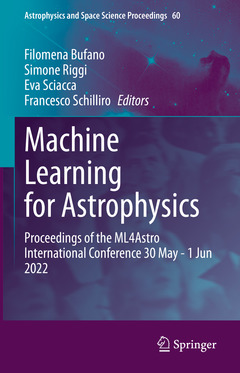Description
Machine Learning for Astrophysics, 1st ed. 2023
Proceedings of the ML4Astro International Conference 30 May - 1 Jun 2022
Astrophysics and Space Science Proceedings Series, Vol. 60
Coordinators: Bufano Filomena, Riggi Simone, Sciacca Eva, Schilliro Francesco
Language: English
Subject for Machine Learning for Astrophysics:
211 p. · 15.5x23.5 cm · Hardback
Description
/li>Contents
/li>Biography
/li>Comment
/li>
This book reviews the state of the art in the exploitation of machine learning techniques for the astrophysics community and gives the reader a complete overview of the field. The contributed chapters allow the reader to easily digest the material through balanced theoretical and numerical methods and tools with applications in different fields of theoretical and observational astronomy. The book helps the reader to really understand and quantify both the opportunities and limitations of using machine learning in several fields of astrophysics.
Machine Learning for H? Emitters Classification.- Stellar Dating Using Chemical Clocks and Bayesian Inference.- Detection of Quasi-Periodic Oscillations in Time Series of a Cataclysmic Variable Using Support Vector Machine.- Dust Extinction from Random Forest Regression of Interstellar Lines.- QSOs Selection in Highly Unbalanced Photometric Datasets: The "Michelangelo" Reverse-Selection Method.- Radio Galaxy Detection Prediction with Ensemble Machine Learning.- A Machine Learning Suite to Halo-Galaxy Connection.- New Applications of Graph Neural Networks in Cosmology.- Detection of Point Sources in Maps of the Temperature Anisotropies of the Cosmic Microwave Background.- Reconstruction and Particle Identification with CYGNO Experiment.- Event Reconstruction for Neutrino Telescopes.- Classification of Evolved Stars with (Unsupervised) Machine Learning Post Proceedings.- Patterns in the Chaos: An Unsupervised View of Galactic Supernova Remnants.- Clustering of Galaxy Spectra: An Unsupervised Approach with Fisher-EM.- Unsupervised Classification Reveals New Evolutionary Pathways.- In Search of the Peculiar: An Unsupervised Approach to Anomaly Detection in the Transient Universe.- Classifying Gamma-Ray Burst X-Ray Afterglows with a Variational Autoencoder.- Reconstructing Blended Galaxies with Machine Learning.- Time Domain Astroinformatics.- A Convolutional Neural Network to Characterise the Internal Structure of Stars.- Finding Stellar Flares with Recurrent Deep Neural Networks.- Planetary Markers in Stellar Spectra: Jupiter-Host Star Classification.- Using Convolutional Neural Networks to Detect and Confirm Exoplanets.- Machine Learning Applied to X-Ray Spectra: Separating Stars from Active Galactic Nuclei.- Classification of System Variability Using A CNN.- Deep Learning Processing and Analysis of Mock Astrophysical Observations.- Deep Neural Networks for Source Detection in Radio Astronomical Maps.- Radio Image Segmentation with Autoencoders.- Citizen Science and Machine Learning: Towards a Robust Large-Scale Automatic Classification in Astronomy.- Background Estimation in Fermi Gamma-Ray Burst Monitor Lightcurves Through a Neural Network.- Machine Learning Investigations for LSST: Strong Lens Mass Modeling and Photometric Redshift Estimation.- Multi-Band Photometry and Photometric Redshifts from Astronomical Images.- Inference of Galaxy Clusters Mass Radial Profiles from Compton-? Maps with Deep Learning Technique.- Deep Learning 21cm Lightcones in 3D.- ConvNets for Enhanced Background Discrimination in the Diffuse Supernova Neutrino-Background (DSNB) Search.- Deep Neural Networks for Single-Line Event Direction Reconstruction in ANTARES.- Cats Vs Dogs, Photons Vs Hadrons.- Events Classification in MAGIC Through Convolutional Neural Network Trained with Images of Observed Gamma-Ray Events.- Federated Learning Meets HPC and Cloud.- Integration and Deployment of Model Serving Framework at Production Scale.- Predictive Maintenance for Array of Cherenkov Telescopes.
Filomena Bufano (Ph.D. in Astronomy) has been a research staff scientist at Istituto Nazionale di Astrofisica (INAF) since 2016. Her scientific interests have been mainly focused on the study of massive stars evolution, in particular on their final stages. Promoting a multi-wavelength approach in her studies, she worked using data from different telescopes/surveys from UV to radio frequencies and has been a member of numerous international collaborations and projects. In view of the approaching era of a deluge of data expected from new ground and space-based facilities, she acquired deep skills in the use of machine learning algorithms: since ~2017 she has been engaged in two important European projects, i.e. ViaLactea and the ongoing NEANIAS project (sponsor of the conference, too). Nowadays, she is involved in the preliminary activities of the Square Kilometre Array focussed on the Galactic Plane and in the Early Science Data Analysis phase of two important pathfinder/precursor of SKA: ASKAP and MeerKAT.
Eva Sciacca (Ph.D. in Mathematics for Technology) is a Computer Scientist and Information Technology researcher with over a decade of experience, working at the Istituto Nazionale di Astrofisica (INAF) since 2012. She has been extensively involved in cutting-edge research activities in the field of big-data, visual analytics, and machine learning. She has been instrumental in facilitating astrophysical data processing on distributed computing infrastructures, with a special focus on High-Performance Computing (HPC) and Cloud Computing. Over the past five years, Eva has played a pivotal role in several European-funded projects, including VIALACTEA, INDIGO-DataCloud, AENEAS, EOSC-Pilot, NEANIAS, and SPACE. She has been at the forefront of harnessing the potential of the European Open Science Cloud (EOSC) and the European High-Performance Computing Joint Undertaking (EuroHPC JU) to advance scientific research, and she isac
These books may interest you

Observational Astrophysics 168.79 €

Observational Astrophysics 121.31 €

Nuclei in the Cosmos 52.74 €

